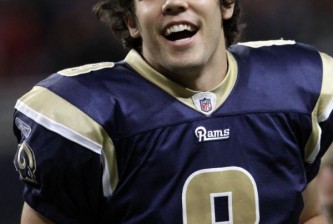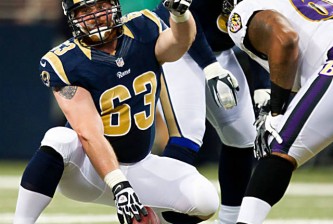Maybe it's a by-product of being a Rams fan, but I have a love for home makeover shows, especially This Old House. The plot is always the same – a homeowner has a falling-down property, and the situation looks hopeless until a salty curmudgeon shows up with a team of expert carpenters, architects and designers. After an hour is over, you've got a completely rebuilt place, restored to its former grandeur and glory.
The story of Jeff Fisher and the 2012 Rams, in other words.
If you've watched these shows, you know the first thing these guys do before they lift a hammer is figure out what they've been given to work with. Some parts of the house are already sturdy and just need a coat of polish; others are obviously rotted and useless and need to be replaced. But there is always something tarnished that these guys take a chance on restoring, rather than replacing.
When you look at the job that Fisher and Les Snead have done, there are key players that this team decided to take a chance on rehabbing rather than replacing, and those key players have made huge contributions to this team's resurgence. And each rehab story comes with a master architect.
Here are the top five:
1: Lance Kendricks (The fixer: TE coach Rob Boras)
Kendricks was very nearly a lost cause after his rookie season, looking like yet another failed Josh McDaniels draft experiment. For a supposed #1 tight end, he couldn't stay on the field, and when he was on the field, he couldn't hold on to the ball.
Drops started to plague him right from the start, failing to bring in a critical third-down pass from Bradford against the Eagles on a perfectly-thrown blitz-beater. That single play unraveled all of the excitement he had built up in what looked like a breakout preseason. And Kendricks played like a haunted man all year long. On the few occasions where he made a big-time catch, he also took a big-time hit that knocked him off the field.
Enter tight ends coach Rob Boras, fresh from a stint in Jacksonville where he coaxed a breakout season from Marcedes Lewis. Boras started his coaching career with the offensive line, and he took a back-to-basics approach to rebuilding Kendricks' play.
As a result, Kendricks has already improved his blocking enough to move underpowered fullback Brit Miller to the unemployment line. By getting more involved in the run game, he has increased his playing time from 61% of the Rams' snaps in 2011 to 81% in 2012.
Perhaps this increased involvement in the offense helped clear the ghosts in Kendricks' head as well, as he has dramatically improved his catch rate from 52% in 2011 (31st of 32 starting TEs) to 73% in 2012 (9th of 34 starting TEs). Scouts always liked his hands coming out of Wisconsin, but they had been little used and little proven. Now we're seeing the proof with big catches on critical plays.
That he had a career-best 100-yard receiving day last weekend is just the outcome of a season-long process of renovation. Good on Lance.
2. Rodger Saffold (The fixer: OL coach Paul Boudreau)
If anything, I'm more surprised to be writing this in December than I would have been in September of this season. Paul Boudreau is a well-credentialed offensive line coach, and the fruits of his work have been apparent all season long. Moreover, Saffold is a talented player who was publicly coveted by the Colts when the Rams drafted him. He did enough good things in his rookie season to make me think that the awfulness of second year could be largely fixable.
But a succession of injuries made me think that there might be too many cracks in his foundation to salvage. First was the season-ending pectoral tear in 2011. Second was a series of minor concussions – small, but they add up (see Smith, Jason). But lastly was a brutally unlucky knee injury suffered in a diving srcum for a fumble in week 1. (He also appeared to get decapitated on the play, for good measure.)
Saffold missed the next seven weeks of the season, but credit to the kid's toughness and commitment, he came back and has been elite in pass protection. Since Saffold came back (and you have to include Wells' return here as well), Bradford's sack rate has dropped from 2.9 sacks per game to 1.7.
Early in the season, we wondered where Saffold's place on the line might be. Now he is entrenching himself at left tackle, making the Rams' draft board a little more flexible at the top — a good thing as their improved record is dropping them out of reach of the top tackles in this class.
3. Sam Bradford (the fixer: QB coach Frank Cignetti)
Arguably, Bradford should be at the top of any list involving the Rams' improved fortunes in 2012. Y'know, franchise quarterback and all. But I've been a staunch defender of his talent. His technique, though, had deteriorated badly in Josh McDaniels' offense and without the benefit of working with a QB coach.
His footwork was trash — thanks to a high ankle sprain. His pocket presence was approaching Jimmy Clausen levels of comedy — thanks to an interior offensive line that cashed their checks and lay down. His vaunted deep ball accuracy was gone — thanks to losing his first, second and third-favorite options at receiver. In short, he was a wreck, but he was far from becoming a David Carr-level insurance writeoff.
Before Cignetti even had to lift a finger, several factors were working toward Bradford's recovery. First, Bradford met Jeff Fisher eye to eye, and showed enough of "it" (whatever "it" is) to convince Fisher to sign on here. Second, he got healthy. Third, he got comfortable with a new offense and a rehabbed group of receivers.
Then Cignetti got to work on the technical side of things. In the first half of the season, we saw Bradford make steady improvements in all the intangible areas: presence, footwork, and confidence. He started looking beyond the short target and reading the route tree from the top down. He made more stick throws to the sidelines, and when Chris Givens started earning playing time, Sam started lofting passes down field.
These were the seeds; Bradford's much-ballyhooed clutch stats (comeback drives, game-tying and game-winning drives, 4th-quarter QBR and all of that) are the fruit.
4. Eugene Sims (the fixer: DL coach Mike Waufle)
Sims has been one of the most pleasant surprises of the year for me, an inherited late-round pick from the Spagnuolo era that never fully developed. Typically, these players are the first to be cut loose in a coaching change, particularly one as sweeping as the Fisher-Snead regime change.
When there's no one left in the building to speak up for you, you have to let your play do the talking. And Sims played loudly enough in camp to stay on, and has continued to work — both in practice and on special teams — to earn a greater share of playing time. He has also become a teacher's pet, soaking up as much in-game coaching as Waufle can dish out. (This is evident from watching the two on the sidelines.)
Together with a Fisher favorite in William Hayes, Sims is part of a "super-sub" defensive line package that can put four DEs on the field at once, capable of throwing an all-out pass rush without losing their gap integrity against draws and screens. But his best work came when he was called on to sub for a hobbled Robert Quinn against San Francisco in week 13 – the second of two five-quarter brawls in less than a month.
Sims collected 3 hurries, 1 hit and 1 sack against Colin Kaepernick, while doing an excellent job of sealing the edge and preventing the highly mobile quarterback from slipping underneath a too-aggressive pass rush. That was one of Quinn's cardinal sins that prevented a Rams win in Week 10.
His snap count has steadily risen, and at this point I actually prefer seeing him in the lineup over Quinn, who has collected only 1 sack, 1 hit and 4 hurries in his last six games combined. (There's a rehab project for next season, Mr. Waufle.)
5. James Laurinaitis (the fixer: Blake Williams and Dave McGinnis)
If it ain't broke, don't fix it, right? Not in the case of the Rams' middle linebacker, whose role has changed dramatically.
After three seasons as good as you could want from Spagnuolo's defensive quarterback, Laurinaitis appeared to be taking a step backwards in 2012 — or sprinting several yards backwards, if you like. Laurinaitis appeared to many to be struggling with his new responsibilities and assignments in a cover-two defense, often appearing to take himself out of plays, and being late to fill running lanes. His tackle count remains high, but the efficiency of those tackles did not. Often his stops came well after the opposing offense had gotten the yards it needed to move the sticks, leaving little to celebrate and many reasons to question his play.
Before the season started, assistant head coach Dave McGinnis called Laurinaitis "the perfect linebacker for this defense," predicting Pro Bowls in his future. While he has continued to captain the defense and made last-second tweaks to alignments all season long, it wasn't until recent weeks that he has displayed the instincts and speed in his individual play that Rams fans recognize.
Last week, he had two signature plays that helped shut down the Buccaneers.
The second play was the more technically and athletically impressive one, his interception of a Josh Williams pass. Laurinaitis reads run and moves toward the line of scrimmage, but like a quarterback does when he realizes the first read isn't there, he rapidly moved through his defensive progression. Changing gears on the fly, he hustled backwards toward a hole in the zone that Vincent Jackson had settled into from his slot position. Jackson had two defenders behind him that were out of position to make a play; only Laurinaitis, eating up that gap, had a chance. He not only closed the gap, he read the receiver's eyes and turned in time to make an acrobatic catch. It was maybe the best play I've seen from a Rams linebacker all season.
However, a play earlier in the game — also on Vincent Jackson, the Bucs' most dangerous weapons — came first in my book. The Bucs were driving down the field in the first quarter, and Josh Freeman found Jackson over the middle for a big catch on third down in the red zone. Now, James is not known for delivering big hits, but he laid lumber on VJax on this catch, plowing him into the ground with a devastating hit.
Jackson came up shaking his head angrily, but two snaps later he saw James steamrolling his way and let a would-be touchdown pass sail harmlessly by.
For Laurinaitis, it was a statement hit, followed by a statement play. He may be behind a trio of NFC West inside linebackers in Pro Bowl voting this season, but if he keeps making these plays, that will change soon.
Honorable Mentions: Quintin Mikell, who has embraced the "Roman Harper" role in this defense; Austin Pettis, who leapfrogged Greg Salas in the offseason and has been a clutch receiver.























-593x356.jpg)